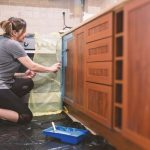By Lauren Sieben
The kitchen may be the heart of the home, but the living room is the hub. It’s where everyone convenes to relax and enjoy quality time with each other (or with the TV). If you’re preparing to list your house, you need to go the extra mile to help prospective new owners see your living room’s full potential.
Today’s buyers expect spaces that are equal parts inviting and updated. We spoke with real estate experts around the country to learn about the living room fixes that can help you attract top dollar in today’s housing market.
1. Let the light in
Forget moody color palettes and heavy window treatments in the living room.
“Buyers want to see homes that are bright, spacious, and inviting, with natural light,” says Tamara Moritz, a Realtor® at Coldwell Banker Realty in Austin, TX. “I always advise my clients to thin out these rooms, open all the blinds and remove darker solar screens, to invite more natural light into the home.”
One of the best living room upgrades to make before you list is new light fixtures, Moritz adds—you can’t go wrong with something bright and simple.
Donna Incorvaja, a Realtor associate and licensed broker at RelatedISG Realty in South Florida, agrees: “The living room should be balanced with a neutral, light, color palette, which will make it easier for the buyers to visualize themselves and their style in your home.”
2. Neutralize the wall colors
At this point, it should go without saying: A fresh coat of paint in a neutral color works wonders to freshen up a dated space and help buyers see its possibilities. White or off-white is a perennial safe bet, but it’s not your only option.
“Buyers in my area are still loving light gray,” says Tracy Jones, a real estate agent with Re/Max Platinum in Sarasota, FL, and Re/Max Oak Crest Realty in Elkhart, IN. “It’s a safe choice for sellers, as it appeals to almost everyone, and sellers can use bold colors to accent with.”
3. Open up the space
If it’s within your budget or skill set to create an open floor in the living room, this project is worth the effort.
“Sellers can remove walls if possible, and barriers such as pony walls,” says Suzi Dailey with Realty ONE Luxe in Dana Point, CA. “Sometimes, near the front door, you see false walls to create a foyer, but removing excess walls is a popular trend today, and it bears good fruit.”
Today’s buyers aren’t interested in their grandma’s stuffy living rooms, so don’t let old-school conventions limit your vision for an open space.
“Formal living rooms are more uncommon nowadays,” Incorvaja says. “It’s very important that the main living room is big and open enough for the whole family to gather together.”
4. Streamline and stage thoughtfully
Once you’ve opened up your space, don’t let a busy room full of furniture and tchotchkes detract from the appeal.
“One of the best tips to increase the living room’s appeal is to declutter furniture,” Incorvaja says. “Keeping the decoration simple and staged well helps buyers visualize their furniture in the home.”
If you’re not sure how to scale back, choose just a few focal pieces to anchor the room.
“I always recommend keeping it simple, with a great piece of art—it doesn’t have to be expensive. A nice plant, and just a few pieces of furniture,” Dailey says.
5. Remove dingy carpeting and replace with wood or tile flooring
Old carpeting is an instant turn-off to prospective buyers.
“Renovations that definitely add value to a home include tile or wood flooring,” Incorvaja says.
If you don’t have the budget for brand-new hardwoods, don’t despair.
“Wood-look vinyl is not only affordable but easy to maintain, and has become an appealing option in lots of price points,” Moritz says.
In some parts of the country, tile is even preferable to wood flooring.
“In Florida, tile is always a popular choice,” Jones says. “Homeowners have been opting for tile that looks like wood. It doesn’t scratch, and holds up well to kids, pets, and wet feet coming in from the pool.”
Whatever you choose, resist the temptation to replace old carpet with new carpet.
“Replacing carpet is not money well spent,” Dailey says. “Most buyers would prefer engineered wood.”
6. Show the room’s versatility
Pre-pandemic, a living room might primarily have served as a hangout spot. These days, it probably pulls double duty as a gym, office or classroom.
“These rooms have evolved into multipurpose rooms that are being furnished to accommodate offices or virtual classrooms during the day, and media rooms or game rooms in the evenings,” Moritz says.
You can set up a nook with a desk and laptop in the living room, or take advantage of extra living spaces like sunrooms or large foyers to stage different options for multipurpose spaces.
“If a rec room is in the basement, use the lack of windows to your advantage,” Dailey says.
She suggests creating “a media/theater/virtual reality type of room, or a hip gym.”
7. Incorporate extra shelving or storage
Storage is always a bonus for buyers, especially in a living room where they may want to hide away blankets, toys, or electronics.
“When there are interesting angles or niches, I recommend adding built-in shelving with lights and accent paint color, to add interest to a room,” Moritz says. “These touches don’t cost a lot, but add character and interest to buyers.”
Don’t overlook dead space around the house that could be transformed into storage.
“If there is an entry staircase, adding a cut-in under the stairs for shelves creates an appealing use of what would otherwise be a blank wall,” Moritz adds.





